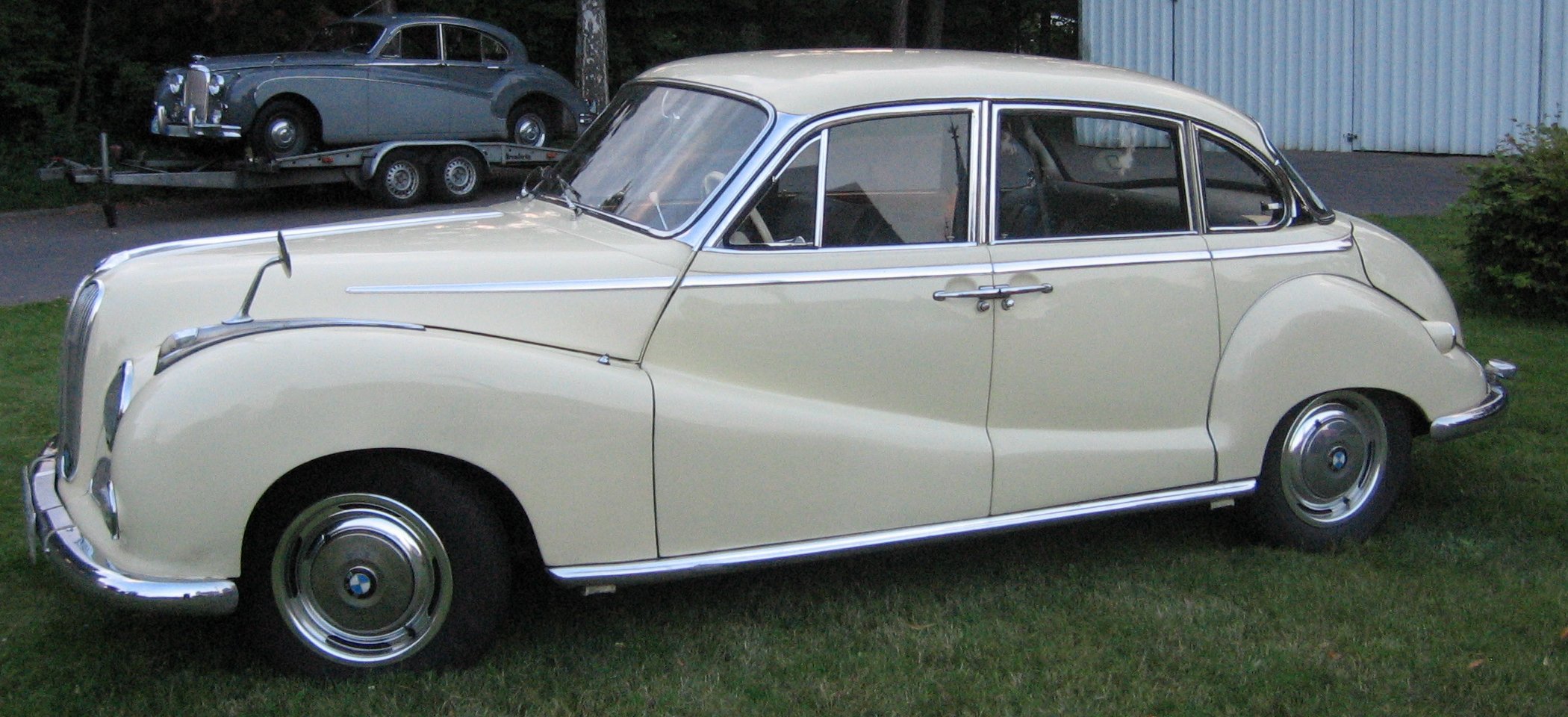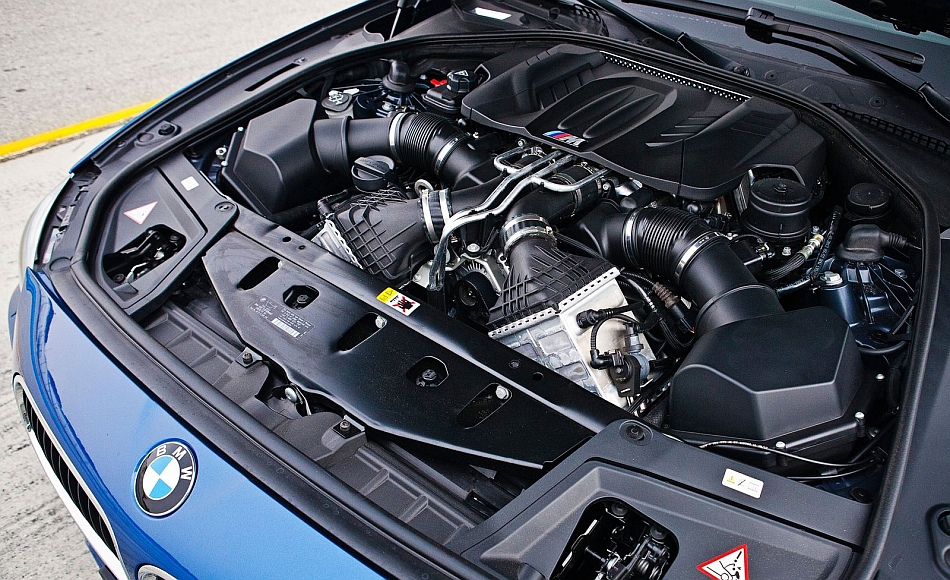It was used in the BMW 502, a sporty update to BMW's first car after WW2, the 501 in response to competition from Mercedes-Benz. It displaced 2.6L and made 100HP.
It was later enlarged and tuned to culminate in a 3.2L engine making 160HP that was fitted to the exclusive BMW 507 roadster which achieved a 0-60mph time of under 10s.
This car was so exclusive and expensive to make, and sold so little (only 252 were ever built - it sold for $10,000 - Elvis had one) that it almost bankrupted BMW.
There followed a quarter century hiatus starting in 1965 during which BMW did not make any V8 engines, sticking to the continued development of the smaller inline 4s and extremely smooth-running and relatively powerful inline 6 engines, and leaving the 8-cylinders beasts to the American muscle cars such as the 1970 Plymouth GTX shown here.

While great in straight line acceleration, these cars were heavy in front due to the massive engines, had poor fuel economy, and poor cornering, which were all areas that were much more important for, and in fact defined, European cars of the time.
BMW meanwhile was working on its New Class platform. It developed what became known as the M10 engine line specifically for it.
The M10 engine was designed by Baron Alex von Falkenhaven, an engineer and race car driver, and was a good part of the reason the New Class was so successful. The basic engine design was an inline 4-cylinder with a single overhead camshaft (SOHC), with sufficient capacity to expand up to 2.0 L of displacement. It lasted until 1987 alongside other inline SOHC 6-cylinder engines whose designs were based upon it (notably the M30 "big six" and the M20 "small six").
A new wave of engine designs were released starting in 1987 including the M40 4-cylinder, the M50 6-cylinder, and the M70 12-cylinder.
 |
| BMW M50 Engine |
Feeling the need to compete at the higher end, BMW was faced with the choice of developing a V8 or a V12. They decided to start with a V12 in order to leapfrog Mercedes and go head-to-head with them at the high end with the E32 7-Series.

As well, a V12 is essentially two inline 6 engines (BMW's speciality) driving a common crankshaft. As each I6 had no first or second order imbalances the V12 was also extremely smooth running and highly performant.
In fact, the M70 V12 shown here in an exploded view is based on two I6 SOHC M20's set at a 60 degree angle to one another.
The V8 moratorium was finally broken by the M60 V8 engine in 1992, though development began in 1984.
The engine was made in two variants, a 3.0L and a 4.0L which appeared in the E34 530i and 540i respectively.
(Recall the 5-Series lineup: 1972 E12, 1981 E28, 1988 E34, 1995 E39, 2003 E60, 2010 F10).
This engine was made from an aluminium block with aluminium cylinder heads. The cylinders were lined with Nikasil, an alloy of aluminium, nickel, and silicon, which is corroded by the high sulfur content of low quality gasoline. BMW extended the warranties and changed the design to use a different alloy, Alusil (still in use today) when the problem was first uncovered.
It introduced the use of 4 valves per cylinder, 4 overhead camshafts, two dual chain timing belts, connecting rods made using a sintering process, a plastic intake manifold, fuel injection, and a new ignition system using individual coils over the plugs to replace the distributor and controlled by the Bosch Motronic 3.3 system.
The larger engine made 282HP, and generated 295ft-lb of torque at 4500rpm.
3. BMW M62/M62TU/S62: 1994 – 2005
The M62 was a straightforward successor of the M60. Slightly larger displacement, and amongst other minor changes, it also replaced the dual timing chains with a single one.
The M62TU (Technical Update) was used in the 1999 model year E39 540i.
This engine displaced 4.4L and made 282HP with 325ft-lb of torque at 3600rpm. It added variable valve timing on the intake camshafts, called VANOS by BMW, and an electronically controlled throttle.
The M Motorsports division put out the S62B50 with enlarged stroke and bore, one electronically actuated throttle body per cylinder for quicker response, and variable valve timing on both the intake and the exhaust for the first time in a BMW (called "Double VANOS"). It was used in the extremely popular and well-loved E39 M5.
This engine displaced 4.9L, made 394HP, and generated 369ft-lb of torque at 3800rpm.
4. BMW N62: 2002 - present
The N62 is the engine used in the E60 5-Series, including the 540i, the 545i, and the 550i (by increasing bore and stroke). It incorporates double VANOS, variable valve lift, and a variable length intake manifold.
The N62B48 used in the E60 550i produced 362 HP and 361ft-lb of torque at 3400 RPM.
This engine was highly regarded and won International Engine of the Year in 2002 for its advanced technology, performance, and reliability.
There was no higher performing "M" variant of this engine. Instead, M built the S85 V10 for the E60 M5, inspired by their involvement in F1 racing engine construction.
5. N63: 2008 - present
The N63B44 engine is BMW's first twin-turbocharged V8 produced in 2008 for the X6 and later for the 750i and F10 550i.
The switch to turbocharging was against BMW's prevailing philosophy of direct naturally aspirated throttle response. They started the switch with the N54 Inline 6 engine in 2006 for use in the E90 335i.
It has two small turbos plus direct fuel injection, however they had to give up variable valve lift. The engine won numerous engine of the year awards, however reliability was plagued by problems with the high pressure fuel pump at the fuel rails.
The V8 N62 was introduced two years later, in 2008. Unique to this new engine is the switch of the usual intake and exhaust valve orientations to allow for twin turbochargers mounted on top in the "V". This lowers the distance from cylinder head to turbo for the exhaust gasses leading to less lag and more low-rpm torque. It uses air-to-water intercoolers to cool the compressed air before it enters the cylinders. The engine displaces 4.4 L and makes 402 HP and 440 ft-lb of torque between 1750 RPM and 4500 RPM, with a 6500 RPM redline. The first application of the engine was in the F01 750i.

Unlike its predecessor, it does not use variable valve lift, as it was not as needed due to the compressed air from the turbochargers minimizing the partial vacuum problem the Valvetronic system was designed to solve. It does, however, use double VANOS to control the timing on both the intake and exhaust camshafts. The turbochargers are of the single scroll design and are isolated one cylinder bank from the other, which because of the uneven cylinder firing inherent in a V8 causes uneven pulses of exhaust gas to flow over the turbos, reducing their efficiency.
The N63 was later upgraded to the N63TU for 2013 following development in Valvetronic for turbocharged engines pioneered in the S63TU engine in the F10 M5.
6. S63 & S63Tu: 2009 - present
The S63B44 is M Motorsport's higher performance variant of the N63 used in the X5M and X6M.
The main differences from the base N63 are the use of twin-scroll turbochargers and a more efficient exhaust manifold that crosses over the exhaust gasses from the cylinder banks for smoother driving of the turbos, and larger intercoolers.
The 2012 model year F10 M5 has the S63B44TU ("Technical Update") engine.
This engine also displaces 4.4 L, but makes 560 HP and 502 ft-lb of torque between 1500 RPM and 5750 RPM, and redlines at 7200 RPM. It adds Valvetronic variable valve lift, doing away with the throttle, which improves throttle pedal responsiveness. It also runs at a higher compression ratio of 10:1, has a higher turbo boost (1.5 bar), larger intercoolers, and larger, more free flowing air intake and exhaust.




























.jpg)
























